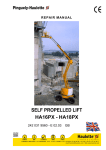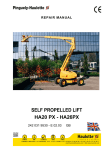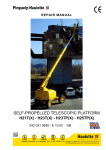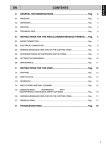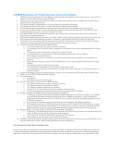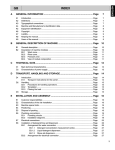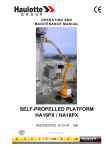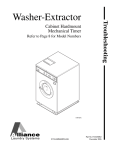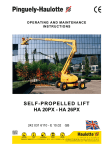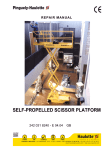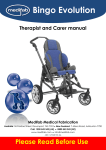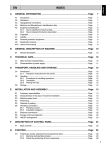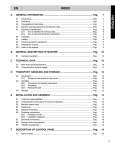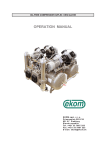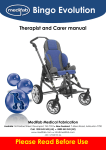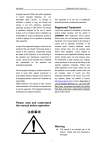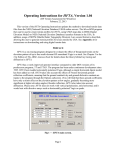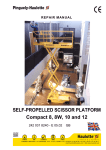Download Users of the manual
Transcript
A B C D Introduction ...................................................................................................................... Page Definitions........................................................................................................................ Page Typographical conventions .............................................................................................. Page Machine and Manufacturer’s identification data............................................................... Page Equipment identification .................................................................................................. Page Copyright ......................................................................................................................... Page Liability............................................................................................................................. Page Personal protection equipment ........................................................................................ Page Keeping the manual......................................................................................................... Page Constructional modifications............................................................................................ Page Users of the manual ........................................................................................................ Page 7 7 7 7 8 8 9 9 9 9 9 10 GENERAL DESCRIPTION OF MACHINE ....................................................... Page 11 B1 B2 11 12 12 12 12 12 12 13 General description ......................................................................................................... Page Description of machine modules ..................................................................................... Page B2.1 Wash zone........................................................................................................... Page B2.2 Rinse zone........................................................................................................... Page B2.3 Prewash zone ...................................................................................................... Page B2.4 Energy recovery/steam suppression unit (CU).................................................... Page B2.5 Drying zone (DT) ................................................................................................. Page B2.6 View of module composition................................................................................ Page TECHNICAL DATA ........................................................................................... Page 14 C1 C2 C3 14 16 17 Main technical characteristics (electric versions) ............................................................ Page Main technical characteristics (steam versions) .............................................................. Page Characteristics of power supply....................................................................................... Page TRANSPORT, HANDLING AND STORAGE.................................................... Page 18 D1 18 18 18 18 18 18 18 D2 D3 E INDEX GENERAL INFORMATION .............................................................................. Page A1 A2 A3 A4 A5 A6 A7 A8 A9 A10 A11 Introduction...................................................................................................................... Page D1.1 Transport: Instructions for the carrier................................................................... Page Handling .......................................................................................................................... Page D2.1 Procedures for handling operations..................................................................... Page D2.2 Translation ........................................................................................................... Page D2.3 Placing the load ................................................................................................... Page Storage ............................................................................................................................ Page INSTALLATION AND ASSEMBLY ................................................................... Page 19 E1 E2 E3 E4 E5 E6 19 19 19 19 19 19 19 25 38 38 38 38 38 E7 E8 ENGLISH GB Customer responsibilities ................................................................................................ Page Characteristics of the place of machine installation......................................................... Page Machine space limits ....................................................................................................... Page Positioning ....................................................................................................................... Page Disposal of packing ......................................................................................................... Page Plumbing connections ..................................................................................................... Page E6.1 Plumbing circuits ................................................................................................. Page E6.2 Installation diagrams............................................................................................ Page Electrical connections...................................................................................................... Page Installation of detergent/rinse aid dispensers .................................................................. Page E8.1 Arrangement for water connection ...................................................................... Page E8.1.1 Detergent concentration measurement probe................................... Page E8.1.2 Liquid detergent dispensers .............................................................. Page 3 E9 E10 F G 44 F1 F2 F3 44 44 45 46 G1 46 46 46 46 46 47 Preliminary checks, adjustments and operational tests ................................................... Page G1.1 Electrical and plumbing checks ........................................................................... Page G1.2 Check the positioning of tank components .......................................................... Page G1.2.1 Check the fitting of filters and overflows ............................................Page G1.2.2 Check the fitting of arms and curtains...............................................Page Starting ............................................................................................................................Page GENERAL SAFETY RULES.............................................................................Page 48 H1 48 48 48 48 48 48 48 49 50 Introduction ......................................................................................................................Page H1.1 Protection devices installed on the machine........................................................Page H1.1.1 Guards .............................................................................................. Page H1.1.2 Safety devices ................................................................................... Page H1.2 Safety signs to be displayed on the machine....................................................... Page Decommissioning ............................................................................................................Page Instructions for use and maintenance .............................................................................. Page Improper use.................................................................................................................... Page Residual risks ..................................................................................................................Page NORMAL MACHINE USE.................................................................................Page 51 I1 I2 I3 51 51 51 51 52 52 52 52 53 53 55 55 55 56 56 57 57 57 57 58 I4 I5 I6 I7 I8 4 Basic controls ..................................................................................................................Page Accessory function selection controls.............................................................................. Page Service alarms/signalling................................................................................................. Page STARTING.........................................................................................................Page H2 H3 H4 H5 I 39 39 39 40 42 42 42 43 43 DESCRIPTION OF CONTROL PANEL ............................................................Page G2 H E8.1.3 Arrangement for solid detergent ........................................................Page E8.1.4 Rinse aid dispensers .........................................................................Page E8.2 Arrangement for electrical connection ................................................................. Page Fitting curtains ................................................................................................................. Page Installation of rack handling systems ...............................................................................Page E10.1 Arrangement for mechanical connection ............................................................. Page E10.2 Arrangement for electrical connection ................................................................. Page E10.3 Positioning of emergency switches......................................................................Page E10.4 Emergency stop reinstatement ............................................................................Page Correct use ......................................................................................................................Page Characteristics of personnel enabled to operate on the machine.................................... Page Daily activation of machine .............................................................................................. Page I3.1 Wash phase.........................................................................................................Page I3.2 Rack jamming ......................................................................................................Page I3.3 Wash phase stop ................................................................................................. Page I3.4 Temperature display ............................................................................................Page I3.5 Loading dishes on racks ......................................................................................Page I3.6 Tank filter cleaning ...............................................................................................Page I3.7 Accessory functions............................................................................................. Page I3.8 Door open ............................................................................................................Page I3.9 Emergency stop...................................................................................................Page I3.10 General alarm......................................................................................................Page Machine cleaning.............................................................................................................Page I4.1 Daily internal cleaning .........................................................................................Page I4.2 Exterior cleaning..................................................................................................Page Long idle periods ............................................................................................................. Page Maintenance .................................................................................................................... Page Machine disposal .............................................................................................................Page Troubleshooting ...............................................................................................................Page ENGLISH GB INDEX OF FIGURES AND TABLES INDEX OF FIGURES Figure 1 Reproduction of the marking/dataplate on the machine..................................................... Page 8 Figure 2 Position of marking (machine left)...................................................................................... Page 8 Figure 3 Position of marking (machine right).................................................................................... Page 8 Figure 4 Technical data identification (Machine right) ...................................................................... Page 8 Figure 5 Example of document and edition identification data......................................................... Page 9 Figure 6 View of different configurations of modular rack-type dishwashers.................................... Page 11 Figure 7 Feet adjustment ................................................................................................................. Page 19 Figure 8 Water connection ............................................................................................................... Page 20 Figure 9 Hole for detergent probe .................................................................................................... Page 38 Figure 10 Arrangement for liquid detergent........................................................................................ Page 38 Figure 11 Prearrangement for solid detergent ................................................................................... Page 39 Figure 12 Solid detergent pipe connection......................................................................................... Page 39 Figure 13 Rinse aid connection.......................................................................................................... Page 39 Figure 14 Diagram of curtain positioning on modular machines ........................................................ Page 41 Figure 15 Handling mechanical connection system ........................................................................... Page 42 Figure 16 Handling electrical connection system ............................................................................... Page 42 Figure 17 Detail of electrical connection ............................................................................................ Page 42 Figure 18 Examples of dishwasher and rack handling system couplings .......................................... Page 43 Figure 19 Prewash module tank filters ............................................................................................... Page 46 Figure 20 Wash module tank filters.................................................................................................... Page 46 Figure 21 Rinse module tank filters.................................................................................................... Page 46 Figure 22 Prewash ............................................................................................................................. Page 46 Figure 23 Wash .................................................................................................................................. Page 46 Figure 24 Rinse .................................................................................................................................. Page 47 Figure 25 Positioning dishes .............................................................................................................. Page 53 Figure 26 Positioning pans ................................................................................................................. Page 53 Figure 27 Positioning trays ................................................................................................................. Page 53 Figure 28 Tank and filter cleaning ...................................................................................................... Page 53 Figure 29 Cleaning filters and arms ................................................................................................... Page 57 INDEX OF TABLES Table 1 Main technical characteristics, performance and consumption (electric versions) ............ Page 14 Table 2 Technical data in “max. power” configuration (165 and 200 racks/h versions)................... Page 15 Table 3 Technical data in “min. power” configuration ...................................................................... Page 15 Table 5 Control panel...................................................................................................................... Page 44 Table 6 Residual risks..................................................................................................................... Page 50 5 Foreword The instruction manual (hereinafter Manual) provides the operator with useful information for working correctly and safely, facilitating him in using the machine (hereinafter “machine”, “dishwasher” or “equipment”). The following must not be considered a long and exacting list of warnings, but rather a set of instructions suitable for improving machine performance in every respect and, above all, preventing injury to persons and animals and damage to property due to improper operating procedures. All persons involved in machine transport, installation, starting, use and maintenance, repair and dismantling must consult and carefully read this manual before performing the various operations, for the purpose of avoiding wrong and improper actions that could negatively affect the machine’s integrity or endanger persons. The manual must always be available to operators and carefully kept in the place where the machine is used so that it is immediately at hand for consultation in case of doubts or whenever required. If, after reading this manual, there are still doubts regarding machine use, do not hesitate to contact the Manufacturer, or the authorized assistance centre, to receive prompt and precise assistance for better operation and maximum efficiency of the machine. During all phases of machine use, always respect the current regulations on safety, work hygiene and environmental protection. It is the user’s responsibility to make sure the machine is started and operated only in optimal safety conditions for persons, animals and property. This appliance is not intended for use by people (including children) with limited physical, sensory or mental abilities or without experience and knowledge of it, unless they are supervised or instructed in its use by a person responsible for their safety. 6 GENERAL INFORMATION A1 Introduction This chapter describes the symbols used (that mark and identify the type of warning) and gives the definitions of terms used in the manual, responsibilities and copyright. A2 Definitions Listed below are the definitions of the main terms used in the Manual. Carefully read them before using the Manual. Operator an operator who carries out machine installation, adjustment, use, maintenance, cleaning, repair and transport. Manufacturer Electrolux Professional S.p.A. or any other assistance centre authorized by Electrolux Professional S.p.A.. Operator qualified for normal machine use an operator who has been informed, instructed and trained regarding the tasks and hazards involved in normal machine use. Specialized technician or Technical assistance an operator instructed/trained by the Manufacturer and who, based on his professional and specific training, experience and knowledge of the accident-prevention regulations, is able to appraise the operations to be carried out on the machine and recognize and prevent possible risks. His professionalism covers the mechanical, electrotechnical and electronics fields. Danger source of possible injury or harm to health. Emergency stop device a group of components intended for the emergency stop function; the device is activated with a single action and prevents or reduces damage to persons/ machines/property/animals. Electrocution an accidental discharge of electric current on a human body. A3 Typographical conventions For best use of the manual, and therefore the machine, it is advisable to have good knowledge of the terms and typographical conventions used in the documentation. The following symbols are used in the manual to mark and identify the various types of hazards: WARNING! DANGER FOR THE HEALTH SAFETY OF OPERATORS. AND WARNING! DANGER OF ELECTROCUTION - DANGEROUS VOLTAGE. Machine guards and protection devices marked with this symbol must only be opened by qualified personnel, after disconnecting the power to the machine. WARNING! DANGER OF DAMAGE TO THE MACHINE. INSTRUCTIONS MARKED WITH THIS SYMBOL INDICATE THE NEED TO: • TURN THE MAIN SWITCH OF THE MACHINE TO “O” (OFF). • LOCK THE MAIN SWITCH WITH THE SPECIAL PADLOCK, AND KEEP THE KEY. Hazardous situation any situation where an operator is exposed to one or more hazards. • DISPLAY A SIGN INDICATING THAT Risk a combination of probabilities and risks of injury or harm to health in a hazardous situation. THE MACHINE IS UNDERGOING MAINTENANCE AND NOT TO CARRY OUT MANOEUVRES. Guards safety measures consisting of the use of specific technical means (guards and safety devices) for protecting operators against dangers. Guard an element of a machine used specifically to provide protection by means of a physical barrier. Safety device a device (other than a guard) that eliminates or reduces the risk; it can be used alone or in combination with a guard. Words and safety warnings further explaining the type of hazard are placed next to the symbols in the text. The warnings are intended to guarantee the safety of personnel and prevent damage to the machine or the product being worked. The drawings and diagrams given in the manual are not in scale. They supplement the written information with an outline, but are not intended to be a detailed representation of the machine supplied. The numerical values given in the machine installation diagrams refer to measurements expressed in mm (see par. E6.2 “Installation diagrams”). Customer the person who purchased the machine and/or who manages and uses it (e.g. company, entrepreneur, firm). 7 ENGLISH A Conventionally, the machines are depicted with the rack feed side on the right (RH); machines with left rack feed (LH) are depicted only if necessary, in which case the side will be expressly specified. Due to its size, the machine is sometimes shown schematically divided into its functional modules in order to provide a complete view. A4 ELX F.Mod. PNC EL WTM165ERA 9CGX 534104 03 AC 400V 3+N Made in EU Comm.Model Ser.Nr. 54500001 50 Hz 2011 40.3 kW Electrolux Professional spa - Viale Treviso, 15 - 33170 Pordenone (Italy) Machine and Manufacturer’s identification data A reproduction of the marking or dataplate on the machine is given below. ELX F.Mod. PNC EL WTM165ERA 9CGX 534104 03 AC 400V 3+N Made in EU Comm.Model Ser.Nr. 54500001 50 Hz Figure 3 Position of marking (machine right) 2011 WARNING! Do not remove, tamper with or make the machine “CE” marking illegible. 40.3 kW IMPORTANT! Refer to the data given on the machine “CE” marking for relations with the Manufacturer (e.g. when ordering spare parts, etc.). Electrolux Professional spa - Viale Treviso, 15 - 33170 Pordenone (Italy) Figure 1 Reproduction of the marking/dataplate on the machine. The dataplate gives the product identification and technical data; the meaning of the information given on it is listed below. F. Mod.................. factory description of the product Comm. Model........ trade description PNC:...................... production code number Ser. No.................. serial number AC 400V 3+N........ power supply voltage 50 Hz.................... power supply frequency 40.3 kW................. max. power absorbed 2011..................... year of construction CE........................ CE marking IPX5..................... protection rating Electrolux Professional S.p.A. Viale Treviso, 15 33170 Pordenone (Italy)................... Manufacturer The marking plate is located on the left (machine left) or right (machine right) side panel of the equipment. ELX F.Mod. PNC EL WTM165ERA 9CGX 534104 03 AC 400V 3+N Made in EU Comm.Model Ser.Nr. 54500001 50 Hz 2011 40.3 kW IMPORTANT! When disposing of the machine the “CE” marking must be destroyed. A5 Equipment identification How to identify the technical data To identify the technical data (Figure 4) read the factory description of the product (F.Mod.) on the dataplate, identify the main machine data and consult the Table 1 “Main technical characteristics, performance and consumption (electric versions)”. . ELX Made in EU F.Mod. WTM140ERA Electrolux Professional spa - Viale Treviso, 15 C1 Main technical characteristics (electric MODEL 140 racks/h Power supply Electrolux Professional spa - Viale Treviso, 15 - 33170 Pordenone (Italy) Electric Power supply voltage V 400 3P+N Frequency Hz 50 or 60 Figure 4 Technical data identification (Machine right) Figure 2 Position of marking (machine left) 8 (1) (2) (3) (4) (5) (6) RT WT M M 140 140 E E R A A A Description Possible variables (1) Mark WT... RT... (2) Machine type M = modular, C = compact (3) Racks/h 140 165 180 200 250 300 (4) Supply E = Electric, S = Steam (5) Rack loading L = from left to right R = from right to left (6) Condensing unit A = with condensing unit B = without condensing unit A6 A8 Copyright This manual is intended for consultation only by the operator and can be given to third parties only with the written permission of Electrolux Professional S.p.A.. A7 Liability The instructions are updated to the month and year given in the box located at the bottom right of the cover. The edition corresponds to the manual revision number. Every new edition replaces and cancels the previous ones. DOC. NO. 5956.521.05 EDITION: 1 05.2011 Number Document Edition Month The employer or workplace manager is responsible for identifying and choosing adequate and suitable personal protection equipment to be worn by operators, in compliance with current regulations in the country of use. Electrolux Professional S.p.A. declines any liability for possible inaccuracies contained in the manual, if due to printing or translation errors. Any supplements to the instruction manual the Customer receives from the Manufacturer must be kept together with the manual, of which they will form an integral part. Year Personal protection equipment Give below is a summary table of the Personal Protection Equipment (PPE) to be used during the various stages of the machine’s service life. Protective garments Gloves Glasses Safety helmet Stage Transport X Handling X Unpacking X Assembly X Normal use Adjustments Routine cleaning Extraordinar y cleaning X X X (*) X X X (*) X X Maintenance X Dismantling X Scrapping X Key: X Figure 5 Example of document and edition identification data. The Manufacturer declines any liability for damage and malfunctioning caused by: • non-compliance with the instructions contained in this manual; • repairs not carried out in a workmanlike fashion, and replacements using spare parts different from those specified in this manual (the fitting and use of non-original spare parts and accessories can negatively affect machine operation); • operations by non-specialized technicians; • unauthorized modifications or operations; • inadequate maintenance; • improper machine use; • unexpected extraordinary events; • use of the machine by uninformed and untrained personnel; • non-application of the current provisions in the country of use, concerning safety, hygiene and health in the workplace. The Manufacturer declines any liability for damage caused by arbitrary modifications and conversions carried out by the user or the Customer. Safety footwear PPE REQUIRED PPE AVAILABLE OR TO BE USED IF NECESSARY PPE NOT REQUIRED (*) During Normal use, gloves protect hands from the contact with chemical substances, water and hot surfaces. Failure to use the personal protection equipment by operators, specialised technicians or users can involve exposure to chemical risk and possible damage to health. A9 Keeping the manual The manual must be carefully kept for the entire life of the machine until decommissioning. The manual must stay with the machine in case of transfer, sale, hire, granting of use or leasing. A10 Constructional modifications The Manufacturer provides for the possibility of connecting the rack-type dishwasher to rack handling systems included in the Electrolux Professional product catalogue, with the possibility of obtaining various configurations. 9 ENGLISH How to interpret the factory description The factory description on the dataplate has the following meaning: The EC Conformity Declaration provided with the machine also envisages these configurations. The Manufacturer does not provide for the possibility of making other constructional modifications to the machine, but allows the execution of other types of combinations with systems different from those described above (in order to create a series of machines arranged and controlled in an integral way), as illustrated in this documentation. In which case it is necessary to comply with provisions of the applicable European Directives or current regulations in the country of use, and obtain the required certifications. The Manufacturer declines any liability for damage caused by arbitrary modifications and conversions carried out by the user or third parties. For requests or for further information, contact Electrolux Professional S.p.A. - Via Treviso, 15 - 33170 Pordenone - Italy. A11 Users of the manual This manual is intended for: • the carrier and handling personnel; • installation and start-up personnel; • the employer of machine users and the workplace manager; • operators in charge of normal machine use; • specialized technicians - technical assistance (see wiring diagram and service manual). 10 B1 GENERAL DESCRIPTION OF MACHINE General description The rack-type dishwasher is suitable for washing dishes, glasses, cups, cutlery, trays, containers and receptacles in plastic and/or steel used for preparing, cooking and serving; as well as various cooking utensils in ceramic and/or metal. The machine is designed for the above-mentioned applications. Under no circumstances may the machine be used for other applications or ways not provided for in this manual. This equipment has been produced to meet the needs for a better work environment and economical efficiency. These dishwashers are used in restaurants, cafeterias, cooking centres and large institutions. The special dish racks, that can be equipped with various inserts, offer practical and easy use for obtaining excellent washing results. Rack handling inside the machine occurs automatically. The electronic system enables complete supervision of the washing process. The control panel also has a display that shows the operating parameters and signals any anomalies. In this type of machine the rack is taken from the loading point to the unloading point, through the various washing functions. Systems for scraping and wetting the dishes (e.g. manual prewash spray) and areas for sorting and arranging them in the racks must be arranged ahead of the dishwasher. The possible configurations of modular rack-type dishwashers, classified according to the maximum number of racks washed in one hour, are as follows: 140 racks/h 200 racks/h 165 racks/h 250 racks/h 180 racks/h 300 racks/h Figure 6 View of different configurations of modular rack-type dishwashers 11 ENGLISH B B2 Description of machine modules The machine consists of the following zones: • wash zone • rinse zone and can be integrated with the following units: • prewash zone • energy recovery/steam suppression unit (CU) • drying zone (DT). B2.1 Wash zone Water with the addition of detergent is sprayed on the dishes in the wash zone through an upper and lower wash arm system. The purpose of this function is to remove all residuals of food from the dishes. Washing is carried out with water circulating at a temperature of 55-65 °C / 131-149 °F. B2.2 Rinse zone Water with the addition of rinse aid is sprayed on the dishes in the rinse zone through a system of arms equipped with special nozzles. The purpose of this function is to remove all residuals of detergent deriving from the previous wash phase. Rinsing is carried out with clean water coming from the water system, heated to a max. temperature of 80-90 °C / 176-194°F. The high temperature ensures satisfactory drying and careful neutralization of bacteria. The addition of rinse aid allows the water to easily run off the dishes, thus favouring the drying process. An extra function called “Duo-rinse” can be implemented in the rinse module”. The “Duo-rinse” is a device that partially recycles the water coming from rinsing, spraying it on the dishes before the actual rinse. In this way the rinse water is collected in a tank and sent by means of a pump to two specific arms equipped with nozzles. This considerably reduces water consumption during the conventional rinse phase. The “Duo-rinse” is only present in the modular rack-type dishwashers. B2.3 Prewash zone Water is sprayed on the dishes in the prewash zone through an upper and lower prewash arm system. The purpose of this function is to remove the larger food residuals, preparing the dishes for the subsequent wash phase. Prewash is carried out with water circulating at a max. temperature of 35°C / 95°F in order to prevent food residuals (in particular proteins) from sticking to the dishes. B2.4 Energy recovery/steam suppression unit (CU) Some rack-type dishwasher versions can be supplied with an energy recovery/steam suppression unit called a condensing unit (CU). It consists of a fan and an air-water heat exchanger. By means of the fan, the steam present inside the wash zone is exhausted and condensed thanks to the heat exchange with the cold water entering; the condensed steam (water) is recovered in the wash tank. This also offers the advantage of heating the cold water entering, recovering a part of the heat that would otherwise be dissipated into the environment. B2.5 Drying zone (DT) The dishes come under a flow of hot air in the drying zone, facilitating the water evaporation process. Drying occurs with hot air at a temperature of 50-60 °C / 122-140 °F. This function can be added at the machine outfeed after the rinse zone. 12 View of module composition In rack-type dishwashers the various zones just described are thus applied to the various previously defined configurations. Rack-type dishwasher - 140 racks/h Rack-type dishwasher - 165 racks/h CU CU Wash Rinse Wash Rack-type dishwasher - 180 racks/h Rinse Rack-type dishwasher - 200 racks/h CU Prewash CU Wash Rinse Prewash Rack-type dishwasher - 250 racks/h Wash Rinse Rack-type dishwasher - 300 racks/h CU Prewash Wash CU Prewash Rinse Wash Rinse Possible drying zone added only at the machine outfeed after the rinse zone Rinse Drying Zone (DT) 13 ENGLISH B2.6 C C1 TECHNICAL DATA Main technical characteristics (electric versions) MODEL Power supply MAIN TECHNICAL DATA PREWASH 250 racks/h 300 racks/h Electric Electric V 400 3P+N 400 3P+N 400 3P+N 400 3P+N 400 3P+N 400 3P+N 50 or 60 50 or 60 50 or 60 50 or 60 50 or 60 50 or 60 Max. power. absorbed (1) (4) kW 27.4 31.5 (3) 32.2 31.8 (3) 44.2 45.3 Max. current. absorbed (2) (4) A 41.4 48.3 (3) 48.7 50.1 (3) 68.2 70.7 H07RN-F H07RN-F H07RN-F H07RN-F H07RN-F H07RN-F 5x25 5x25 5x25 5x25 5x25 5x25 A Main switch A 125A 3P+N 125A 3P+N 125A 3P+N 125A 3P+N 125A 3P+N 125A 3P+N Supply water pressure kPa [bar] 150..700 [1.5..7] 150..700 [1.5..7] 150..700 [1.5..7] 150..700 [1.5..7] 150..700 [1.5..7] 150..700 [1.5..7] Hot water supply temp. °C/°F 50/122 50/122 50/122 50/122 50/122 50/122 Cold water supply temp. °C/°F 15/59 15/59 15/59 15/59 15/59 15/59 Concentration of chlorides in water ppm < 20 < 20 < 20 < 20 < 20 < 20 Electric conductivity of water μS/cm < 400 < 400 < 400 < 400 < 400 < 400 Supply water hardness °fH/°dH/°cH 14/8/10 14/8/10 14/8/10 14/8/10 14/8/10 14/8/10 Rack loading/feed RH machine LH machine From right to left From left to right From right to left From left to right From right to left From left to right From right to left From left to right From right to left From left to right From right to left From left to right 2 2 2 2 2 2 Capacity speed 1 racks/h 80 90 110 130 160 180 Capacity speed 2 racks/h 140 165 180 200 250 300 Air emission m3/h 180 180 180 180 180 180 Emitted air temperature °C/°F 20-25/68-77 20-25/68-77 20-25/68-77 20-25/68-77 20-25/68-77 20-25/68-77 Water consumption l/h 250 315 325 330 345 360 Equivalent sound pressure level Leq (5) dB(A) < 70 < 70 < 70 < 70 < 70 < 70 IPX5 IPX5 IPX5 IPX5 IPX5 IPX5 kg 410 442 570 602 692 724 tank capacity l - - 45 45 100 150 temperature °C/°F - - max. 35 / 95 max. 35 / 95 max. 35 / 95 max. 35 / 95 pump delivery l/min 150 150 600 500 + 350 No. speeds Net weight (6) WASH 200 racks/h Electric Hz Protection rating DUO RINSE 180 racks/h Electric Frequency Power cable RINSE 165 racks/h Electric Power supply voltage Type of power cable CU 140 racks/h Electric pump power kW current absorbed by pump A - - 0.23 0.23 2.2 2.2 + 1.1 0.8 0.8 4.8 4.8 + 2.5 tank heating element (7) kW - - 10.5 10.5 16.5 16.5 module inlet minimum feed flow rate l/min 4 4 4 4 4 4 tank capacity l 100 150 100 150 150 150 temperature °C/°F 55-65 / 131-149 55-65 / 131-149 55-65 / 131-149 55-65 / 131-149 55-65 / 131-149 55-65 / 131-149 pump delivery l/min 600 500 + 350 600 500 + 350 500 + 350 500 + 350 pump power kW 2.2 2.2 + 1.1 2.2 2.2 + 1.1 2.2 + 1.1 2.2 + 1.1 current absorbed by pumps A 4.8 4.8 + 2.5 4.8 4.8 + 2.5 4.8 + 2.5 4.8 + 2.5 tank heating element kW 6.0 + 6.0 10.5 + 10.5 6.0 + 6.0 10.5 + 10.5 10.5 + 10.5 10.5 + 10.5 module inlet minimum feed flow rate l/min 4 4 4 4 4 4 tank capacity l 23 23 23 23 23 23 temperature °C/°F 60-70 / 140-158 60-70 / 140-158 60-70 / 140-158 60-70 / 140-158 60-70 / 140-158 60-70 / 140-158 15 pump delivery l/min 15 15 15 15 15 pump power kW 0.35 0.35 0.35 0.35 0.35 0.35 current absorbed by pump A 0.8 0.8 0.8 0.8 0.8 0.8 tank heating element kW 3 3 3 3 3 3 temperature °C/°F 80-90 / 176-194 80-90 / 176-194 80-90 / 176-194 80-90 / 176-194 80-90 / 176-194 80-90 / 176-194 pump delivery l/min 4 5 5 5 5 5 pump power kW 0.35 0.35 0.35 0.35 0.35 0.35 current absorbed by pump A 0.8 0.8 0.8 0.8 0.8 0.8 boiler heating elements kW 6.0 + 6.0 10.5 + 6.0 10.5 + 6.0 10.5 + 6.0 10.5 + 6.0 10.5 + 6.0 boiler capacity l 12 12 12 12 12 12 module inlet minimum feed flow rate l/min 5 6 6 6 6 6 fan motor power kW 0.13 0.13 0.13 0.13 0.13 0.13 current absorbed by fan A 0.4 0.4 0.4 0.4 0.4 0.4 Table 1 Main technical characteristics, performance and consumption (electric versions) (1) For versions without condensing unit (CU) deduct 0.13 kW. (2) For versions without condensing unit (CU) deduct 0.4 A. (3) In 165 racks/h and 200 racks/h versions the “max. power” option can be activated by means of software. In this configuration the dishwasher will have power and absorbed current values given in Table 2. Activation of this configuration is advisable whenever the dishwasher is used continuously for many hours to wash thick ceramics. MODEL 165 racks/h 200 racks/h Max. power. absorbed kW 42.0 42.3 Max. current. absorbed A 63.4 65.2 14 MODEL 140 racks/h 165 racks/h 180 racks/h 200 racks/h 250 racks/h 300 racks/h Max. power. absorbed kW 18.4 24.0 23.2 24.3 30.7 31.8 Max. current. absorbed A 31.6 40.6 38.9 41.4 51.9 54.4 Table 3 Technical data in “min. power” configuration (5) The value could increase depending on the work station where measured. (6) For versions without condensing unit (CU) deduct 42 kg. (7) Only in versions with sanitization cycle. ** In machines equipped with DT, to determine the absorbed powers/absorbed currents, add the absorbed current/power values to those given in the similar table in the DT instruction manual. 15 ENGLISH Table 2 Technical data in “max. power” configuration (165 and 200 racks/h versions) (4) For users requiring an installed power lower than the standard (Table 1) the “min. power” option can be activated by means of software. In this configuration the dishwasher will have power and absorbed current values given in Table 3. Since the tank and boiler heating elements do not work at the same time in this configuration, activation is advisable whenever use is not continuous (e.g. 30 minutes rack washing and at least 15 minutes wait for racks). C2 Main technical characteristics (steam versions) MODEL Power supply MAIN TECHNICAL DATA PREWASH 250 racks/h 300 racks/h Steam Steam V 400 3P+N 400 3P+N 400 3P+N 400 3P+N 400 3P+N 400 3P+N 50 or 60 50 or 60 50 or 60 50 or 60 50 or 60 50 or 60 Max. power. absorbed kW 6.4 7.5 6.6 7.7 9.7 10.8 Max. current. absorbed A 17.8 20.3 18.6 21.1 25.1 27.6 Steam consumption kg/h 92 92 92 92 92 92 H07RN-F H07RN-F H07RN-F H07RN-F H07RN-F H07RN-F 5x25 5x25 5x25 5x25 5x25 5x25 A Main switch A 125A 3P+N 125A 3P+N 125A 3P+N 125A 3P+N 125A 3P+N 125A 3P+N Supply water pressure kPa [bar] 150..700 [1.5..7] 150..700 [1.5..7] 150..700 [1.5..7] 150..700 [1.5..7] 150..700 [1.5..7] 150..700 [1.5..7] Inlet steam relative dynamic pressure kPa [bar] 150..300 [1.5..3] 150..300 [1.5..3] 150..300 [1.5..3] 150..300 [1.5..3] 150..300 [1.5..3] 150..300 [1.5..3] Hot water supply temp. °C/°F 50/122 50/122 50/122 50/122 50/122 50/122 Cold water supply temp. °C/°F 15/59 15/59 15/59 15/59 15/59 15/59 Concentration of chlorides in water ppm < 20 < 20 < 20 < 20 < 20 < 20 Electric conductivity of water μS/cm < 400 < 400 < 400 < 400 < 400 < 400 Supply water hardness °fH/°dH/°cH 14/8/10 14/8/10 14/8/10 14/8/10 14/8/10 14/8/10 Rack loading/feed RH machine LH machine From right to left From left to right From right to left From left to right From right to left From left to right From right to left From left to right From right to left From left to right From right to left From left to right 2 2 2 2 2 2 Capacity speed 1 racks/h 80 90 110 130 160 180 Capacity speed 2 racks/h 140 165 180 200 250 300 Air emission m3/h 180 180 180 180 180 180 Emitted air temperature °C/°F 20-25/68-77 20-25/68-77 20-25/68-77 20-25/68-77 20-25/68-77 20-25/68-77 Water consumption l/h 250 315 325 330 345 360 Equivalent sound pressure level Leq (5) dB(A) < 70 < 70 < 70 < 70 < 70 < 70 IPX5 IPX5 IPX5 IPX5 IPX5 IPX5 kg 410 442 570 602 692 724 No. speeds Net weight WASH 200 racks/h Steam Hz Protection rating DUO RINSE 180 racks/h Steam Frequency Power cable RINSE 165 racks/h Steam Power supply voltage Type of power cable CU 140 racks/h Steam tank capacity l - - 45 45 100 150 temperature °C/°F - - max 35 / 95 max 35 / 95 max 35 / 95 max 35 / 95 pump delivery l/min 150 150 600 500 + 350 pump power kW - - 0.23 0.23 2.2 2.2 + 1.1 current absorbed by pump A 0.8 0.8 4.8 4.8 + 2.5 Steam consumption (7) kg/h - - 25 25 65 65 module inlet minimum feed flow rate l/min 4 4 4 4 4 4 tank capacity l 100 150 100 150 150 150 temperature °C/°F 55-65 / 131-149 55-65 / 131-149 55-65 / 131-149 55-65 / 131-149 55-65 / 131-149 55-65 / 131-149 pump delivery l/min 600 500 + 350 600 500 + 350 500 + 350 500 + 350 pump power kW 2.2 2.2 + 1.1 2.2 2.2 + 1.1 2.2 + 1.1 2.2 + 1.1 current absorbed by pumps A 4.8 4.8 + 2.5 4.8 4.8 + 2.5 4.8 + 2.5 4.8 + 2.5 Steam consumption kg/h 65 65 65 65 65 65 module inlet minimum feed flow rate l/min 4 4 4 4 4 4 tank capacity l 23 23 23 23 23 23 temperature °C/°F 60-70 / 140-158 60-70 / 140-158 60-70 / 140-158 60-70 / 140-158 60-70 / 140-158 60-70 / 140-158 15 pump delivery l/min 15 15 15 15 15 pump power kW 0.35 0.35 0.35 0.35 0.35 0.35 current absorbed by pump A 0.8 0.8 0.8 0.8 0.8 0.8 tank heating element kW 3 3 3 3 3 3 temperature °C/°F 80-90 / 176-194 80-90 / 176-194 80-90 / 176-194 80-90 / 176-194 80-90 / 176-194 80-90 / 176-194 pump delivery l/min 4 5 5 5 5 5 pump power kW 0.35 0.35 0.35 0.35 0.35 0.35 current absorbed by pump A 0.8 0.8 0.8 0.8 0.8 0.8 Steam consumption kg/h 27 27 27 27 27 27 boiler capacity l 11 11 11 11 11 11 module inlet minimum feed flow rate l/min 5 6 6 6 6 6 fan motor power kW 0.13 0.13 0.13 0.13 0.13 0.13 current absorbed by fan A 0.4 0.4 0.4 0.4 0.4 0.4 Table 4 Main technical characteristics, performance and consumption (steam versions) (5) The value could increase depending on the work station where measured. (7) Only in versions with sanitization cycle. ** For machines equipped with DT, to determine steam consumption, add the steam consumption values to those given in the similar technical data table in the DT instruction handbook. 16 Characteristics of power supply The AC power supply to the machine must meet the following conditions: • max. voltage variation ± 10% • max. frequency variation ± 1% continuous ± 2% for a short period. Harmonic distorsion, unbalanced three-phase supply voltage, voltage pulses, interruption, dips and the other electric characteristics must respect the provisions of point 4.3.2 of Standard EN 60204-1 (IEC 60204-1). IMPORTANT! The machine’s power supply must be protected against overcurrents (short circuits and overloads) by fuses or suitable thermal magnetic circuit breakers. IMPORTANT! For protection against indirect contacts (depending on the type of supply provided for and connection of earths to the equipotential protection circuit) refer to point 6.3.3 of EN 60204-1 (IEC 60204-1) with the use of protection devices that ensure automatic cut-off of the supply in case of isolation fault in the TN or TT systems or, for IT systems, the use of isolation controllers or differential current protection devices to activate automatic power disconnection (an isolation controller must be provided for indicating a possible first earth fault of a live part, unless a protection device is supplied for switching off the power in case of a such a fault. This device must activate an acoustic and/or visual signal which must continue for the entire duration of the fault). For example: in a TT system, a differential switch with cut-in current (e.g. 30 mA) coordinated with the earthing system of the building where the machine is located must be installed ahead of the supply. IMPORTANT! Customers are requested to follow these instructions, otherwise the Manufacturer does not guarantee the machine for continuous operation and/or against faults. 17 ENGLISH C3 D D1 TRANSPORT, HANDLING AND STORAGE Introduction • Transport (i.e. transfer of the machine from one place to another) and handling (i.e. transfer inside workplaces) must occur with the use of special equipment of adequate capacity. IMPORTANT! Due to its size, during transport, handling and storage one machine cannot be stacked on top of another, therefore possible risks of load overturning are excluded. The machine must only be transported, handled and stored by qualified personnel, who must have: - specific technical training and experience; - knowledge of the safety regulations and applicable laws in the relevant sectors; - knowledge of the general safety provisions; - the ability to recognize and avoid any possible hazard. D1.1 Transport: Instructions for the carrier WARNING! Do not stand under suspended loads during the loading/unloading phases. Unauthorized personnel must not access the work zone. IMPORTANT! The machine’s weight alone is not sufficient to keep it steady. The transported load can shift: - when braking; - when accelerating; - in corners; - on particularly rough roads. D2 Handling Arrange a suitable area with flat floor for machine unloading and storage operations. D2.1 Procedures for handling operations For correct and safe lifting operations: • use the type of equipment most suitable for characteristics and capacity (e.g. lift trucks or electric pallet truck); • cover sharp edges; • check the forks and lifting procedures according to the instructions given on the packing. Before lifting: • send all operators to a safe position and prevent persons from accessing the handling zone; • make sure the load is stable; • make sure no material can fall during lifting, and manoeuvre vertically in order to avoid impacts; 18 handle the machine, keeping it at minimum height from the ground. CAUTION! For machine lifting, do not use movable or weak parts such as casings, electrical raceways, pneumatic parts, etc., as anchoring points. D2.2 Translation The operator must: • have a general view of the path to be followed; • stop the manoeuvre in case of hazardous situations. D2.3 Placing the load Before placing the load make sure the path is free and that the floor is flat and can take the load. D3 Storage The machine and/or its parts must be stored and protected against damp, in a non-aggressive place free of vibrations and with room temperature of between -10°C / 14°F and 50°C / 122°F. The place where the machine is stored must have a flat support surface in order to avoid any twisting of the machine or damage to the support feet. IMPORTANT! Machine positioning, installation and disassembly must be carried out by a specialized technician. IMPORTANT! Do not make modifications to the parts supplied with the machine. Any missing or faulty parts must be replaced with original parts. INSTALLATION AND ASSEMBLY IMPORTANT! Machine installation operations must only be carried out by specialized Technicians provided with all the appropriate personal protection equipment (safety shoes, gloves, glasses, overalls, etc.), tools, utensils and ancillary means. Arranging the machine: • Position the machine in the required place. • Adjust the equipment by turning the special adjustable feet and making sure it is perfectly level, both lengthwise and crosswise. IMPORTANT! Make sure the MAIN SWITCH of the machine is locked in the Off position - “O”. E1 Customer responsibilities The Customer must provide for the following: - installation of an adequate electrical power supply ahead of the machine, according to the equipment’s technical specifications (Table 1 and C3 “Characteristics of power supply”); - the equipotential connection of the workplace electrical system to the metal structure of the machine by means of a copper cable of adequate section (see position “Q” in par. E6.2 “Installation diagrams”); - Adducting for the electrical connection between the workplace electric panel and the equipment; - the water supply and drain connections and other connections as indicated in Table 1 and par. E6 “Plumbing connections”. Figure 7 Feet adjustment • • Wear protective gloves and unpack the machine. Carefully remove the protective film from the outer panels without tearing it, to avoid leaving traces of glue. E5 Disposal of packing All materials used for packing are environmentally compatible. They can be safely kept, and recycled or burnt in a special waste incineration plant. Plastic parts subject to possible recycling are marked as follows: polyethylene: outer wrapping, instruction booklet bag. polypropylene: roof packing panels, straps. corner protectors. PE E2 Characteristics of the place of machine installation The machine is designed for installation in professional and not domestic-type kitchens. Water collection traps/ metal grates must be arranged in the floor at the machine discharges (see par. E6.2 “Installation diagrams”), possibly replaceable with a single water trap sized for a flow rate of at least 3 l/s. PP PS Parts in wood and cardboard can be disposed of respecting the current regulations in the country of use. E6 E3 Machine space limits A suitable space must be left around the machine (for operations, maintenance, etc.). The passages enabling personnel to operate on the machine must be at least 70 cm wide, except at the rear of the machine (see par. E6.2 “Installation diagrams”). The size must be increased in case of use and/or transfer of other equipment and/or means or if exit routes are necessary inside the workplace. E4 Positioning Unless otherwise agreed, the machine is supplied in a single unit. The machine must be taken to the place of installation and the packing base removed only when being installed. polystyrene foam: Plumbing connections Install the machine water filling and drain pipes according to the plumbing circuit and installation diagrams given below. E6.1 Plumbing circuits Cold water connection ISO 228/1 DN 20 (G3/4”). 10-15°C 150 - 700 kPa (1.5-7 bar) at 0.3 l/sec Hot water connection ISO 228/1 DN 20 (G3/4”). 50-65°C 150 - 700 kPa (1.5-7 bar) at 0.3 l/sec If the pressure at one of the unions exceeds 700 kPa (7 bar), a pressure reducing valve must be installed on the inlet piping. Connection pipes with anti-return protection and check valve and stop cock are available as optional accessories. If the water hardness exceeds 14°fH/8°dH/10°cH, install a softener filter on the dishwasher inlet connection piping to ensure efficient machine operation. 19 ENGLISH E IMPORTANT! Connect the wash zone to the hot water inlet; connect the prewash zone to the cold water inlet and connect the rinse zone to the hot water inlet if the condensing unit (CU) is not present, and to the cold water inlet if the CU is present. ! Connect the equipment water supply pipes to the water system, interposing a cock, filter and pressure gauge. Figure 8 Water connection Dishwasher plumbing circuit diagram 140 racks/h without CU Dishwasher plumbing circuit diagram 140 racks/h with CU 3 180 m /h YV1 YV1 M6 ABV ABV M2 C ABV 80-90°C 55-65°C 80-90°C 55-65°C 60-70°C 60-70°C M1 M7 YV8 YV6 M1 M7 YV2 YV7 20 YV8 YV6 YV2 YV7 A LEGEND A = Hot water inlet (~ 50°C) B = Cold water inlet (~ 15°C) C = Variable shutter (max 7 l/min) M1 = Duo-Rinse pump M2 = Rinse pump M4 = Upper arms wash pump M5 = Lower arms wash pump M6 = CU fan motor M7 = Wash pump M8 = Prewash pump M10 = Upper arms prewash pump M11 = Lower arms prewash pump ABV = Air Break Valve YV1 = Air-Gap filling solenoid valve (20 l/min) YV2 = Duo-Rinse tank drain solenoid valve M2 C A B YV3 = Wash tank water filling solenoid valve (20 l/min) YV4 = Wash pump discharge solenoid valve YV5 = Wash tank drain solenoid valve YV6 = Wash or prewash tank water filling solenoid valve (20 l/min) YV7 = Wash or prewash pump discharge solenoid valve YV8 = Wash or prewash tank drain solenoid valve YV9 = Prewash tank water filling solenoid valve (20 l/min) YV10 = Prewash pump discharge solenoid valve YV11 = Prewash tank drain solenoid valve YV12 = Prewash tank water filling solenoid valve (20 l/min) YV13 = Prewash pump discharge solenoid valve YV14 = Prewash tank drain solenoid valve YV15 = Prewash tank water filling solenoid valve (20 l/min) YV16 = Prewash pump discharge solenoid valve YV17 = Prewash tank drain solenoid valve ENGLISH Dishwasher plumbing circuit diagram 165 racks/h without CU Dishwasher plumbing circuit diagram 165 racks/h with CU 3 180 m /h YV1 YV1 M6 ABV ABV M2 C ABV 80-90°C 55-65°C 80-90°C 55-65°C 60-70°C 60-70°C M1 M4 M5 YV5 M1 M4 YV2 YV3 M2 C M5 YV5 YV4 YV3 YV2 YV4 A A B Plumbing circuit diagram, dishwashers - 180 racks/h without CU YV1 ABV M2 C 80-90°C 55-65°C Max 35°C 60-70°C M1 YV11 M8 M7 YV5 YV9 YV10 YV3 YV2 YV4 B LEGEND A = Hot water inlet (~ 50°C) B = Cold water inlet (~ 15°C) C = Variable shutter (max 7 l/min) M1 = Duo-Rinse pump M2 = Rinse pump M4 = Upper arms wash pump M5 = Lower arms wash pump M6 = CU fan motor M7 = Wash pump M8 = Prewash pump M10 = Upper arms prewash pump M11 = Lower arms prewash pump ABV = Air Break Valve YV1 = Air-Gap filling solenoid valve (20 l/min) YV2 = Duo-Rinse tank drain solenoid valve A YV3 = Wash tank water filling solenoid valve (20 l/min) YV4 = Wash pump discharge solenoid valve YV5 = Wash tank drain solenoid valve YV6 = Wash or prewash tank water filling solenoid valve (20 l/min) YV7 = Wash or prewash pump discharge solenoid valve YV8 = Wash or prewash tank drain solenoid valve YV9 = Prewash tank water filling solenoid valve (20 l/min) YV10 = Prewash pump discharge solenoid valve YV11 = Prewash tank drain solenoid valve YV12 = Prewash tank water filling solenoid valve (20 l/min) YV13 = Prewash pump discharge solenoid valve YV14 = Prewash tank drain solenoid valve YV15 = Prewash tank water filling solenoid valve (20 l/min) YV16 = Prewash pump discharge solenoid valve YV17 = Prewash tank drain solenoid valve 21 Plumbing circuit diagram, dishwashers - 180 racks/h with CU 3 180 m /h YV1 M6 ABV ABV C 80-90°C 55-65°C Max 35°C M2 60-70°C M1 M7 M8 YV11 YV8 YV9 YV10 YV6 YV2 YV7 A B Plumbing circuit diagram, dishwashers - 200 racks/h without CU YV1 ABV M2 C Max 35°C 80-90°C 55-65°C 60-70°C M1 YV11 M8 YV9 M4 YV5 M5 YV3 YV2 YV10 YV4 B LEGEND A = Hot water inlet (~ 50°C) B = Cold water inlet (~ 15°C) C = Variable shutter (max 7 l/min) M1 = Duo-Rinse pump M2 = Rinse pump M4 = Upper arms wash pump M5 = Lower arms wash pump M6 = CU fan motor M7 = Wash pump M8 = Prewash pump M10 = Upper arms prewash pump M11 = Lower arms prewash pump ABV = Air Break Valve YV1 = Air-Gap filling solenoid valve (20 l/min) YV2 = Duo-Rinse tank drain solenoid valve 22 A YV3 = Wash tank water filling solenoid valve (20 l/min) YV4 = Wash pump discharge solenoid valve YV5 = Wash tank drain solenoid valve YV6 = Wash or prewash tank water filling solenoid valve (20 l/min) YV7 = Wash or prewash pump discharge solenoid valve YV8 = Wash or prewash tank drain solenoid valve YV9 = Prewash tank water filling solenoid valve (20 l/min) YV10 = Prewash pump discharge solenoid valve YV11 = Prewash tank drain solenoid valve YV12 = Prewash tank water filling solenoid valve (20 l/min) YV13 = Prewash pump discharge solenoid valve YV14 = Prewash tank drain solenoid valve YV15 = Prewash tank water filling solenoid valve (20 l/min) YV16 = Prewash pump discharge solenoid valve YV17 = Prewash tank drain solenoid valve ENGLISH Plumbing circuit diagram, dishwashers - 200 racks/h with CU 3 180 m /h YV1 M6 ABV ABV 80-90°C 55-65°C Max 35°C M2 C 60-70°C M1 YV11 M8 M4 M5 YV5 YV9 YV3 YV2 YV10 YV4 A B Plumbing circuit diagram, dishwashers - 250 racks/h without CU YV1 ABV M2 C Max 35°C 80-90°C 55-65°C 60-70°C M1 M7 YV14 YV12 M4 YV5 M5 YV3 YV2 YV13 YV4 B LEGEND A = Hot water inlet (~ 50°C) B = Cold water inlet (~ 15°C) C = Variable shutter (max 7 l/min) M1 = Duo-Rinse pump M2 = Rinse pump M4 = Upper arms wash pump M5 = Lower arms wash pump M6 = CU fan motor M7 = Wash pump M8 = Prewash pump M10 = Upper arms prewash pump M11 = Lower arms prewash pump ABV = Air Break Valve YV1 = Air-Gap filling solenoid valve (20 l/min) YV2 = Duo-Rinse tank drain solenoid valve A YV3 = Wash tank water filling solenoid valve (20 l/min) YV4 = Wash pump discharge solenoid valve YV5 = Wash tank drain solenoid valve YV6 = Wash or prewash tank water filling solenoid valve (20 l/min) YV7 = Wash or prewash pump discharge solenoid valve YV8 = Wash or prewash tank drain solenoid valve YV9 = Prewash tank water filling solenoid valve (20 l/min) YV10 = Prewash pump discharge solenoid valve YV11 = Prewash tank drain solenoid valve YV12 = Prewash tank water filling solenoid valve (20 l/min) YV13 = Prewash pump discharge solenoid valve YV14 = Prewash tank drain solenoid valve YV15 = Prewash tank water filling solenoid valve (20 l/min) YV16 = Prewash pump discharge solenoid valve YV17 = Prewash tank drain solenoid valve 23 Plumbing circuit diagram, dishwashers - 250 racks/h with CU 3 180 m /h YV1 M6 ABV ABV Max 35°C M2 C 80-90°C 55-65°C 60-70°C M1 M7 YV14 M4 YV12 M5 YV5 YV2 YV3 YV13 YV4 A B Plumbing circuit diagram, dishwashers - 300 racks/h without CU YV1 ABV M2 C 80-90°C 55-65°C Max 35°C 60-70°C M1 M10 YV17 YV16 M11 YV15 M4 YV5 M5 YV3 YV2 YV4 B LEGEND A = Hot water inlet (~ 50°C) B = Cold water inlet (~ 15°C) C = Variable shutter (max 7 l/min) M1 = Duo-Rinse pump M2 = Rinse pump M4 = Upper arms wash pump M5 = Lower arms wash pump M6 = CU fan motor M7 = Wash pump M8 = Prewash pump M10 = Upper arms prewash pump M11 = Lower arms prewash pump ABV = Air Break Valve YV1 = Air-Gap filling solenoid valve (20 l/min) YV2 = Duo-Rinse tank drain solenoid valve 24 A YV3 = Wash tank water filling solenoid valve (20 l/min) YV4 = Wash pump discharge solenoid valve YV5 = Wash tank drain solenoid valve YV6 = Wash or prewash tank water filling solenoid valve (20 l/min) YV7 = Wash or prewash pump discharge solenoid valve YV8 = Wash or prewash tank drain solenoid valve YV9 = Prewash tank water filling solenoid valve (20 l/min) YV10 = Prewash pump discharge solenoid valve YV11 = Prewash tank drain solenoid valve YV12 = Prewash tank water filling solenoid valve (20 l/min) YV13 = Prewash pump discharge solenoid valve YV14 = Prewash tank drain solenoid valve YV15 = Prewash tank water filling solenoid valve (20 l/min) YV16 = Prewash pump discharge solenoid valve YV17 = Prewash tank drain solenoid valve ENGLISH Plumbing circuit diagram, dishwashers - 300 racks/h with CU 3 180 m /h YV1 M6 ABV ABV 80-90°C 55-65°C Max 35°C M2 C 60-70°C M1 M10 YV17 M11 M4 YV15 YV16 YV5 M5 YV3 YV2 YV4 A LEGEND A = Hot water inlet (~ 50°C) B = Cold water inlet (~ 15°C) C = Variable shutter (max 7 l/min) M1 = Duo-Rinse pump M2 = Rinse pump M4 = Upper arms wash pump M5 = Lower arms wash pump M6 = CU fan motor M7 = Wash pump M8 = Prewash pump M10 = Upper arms prewash pump M11 = Lower arms prewash pump ABV = Air Break Valve YV1 = Air-Gap filling solenoid valve (20 l/min) YV2 = Duo-Rinse tank drain solenoid valve E6.2 B YV3 = Wash tank water filling solenoid valve (20 l/min) YV4 = Wash pump discharge solenoid valve YV5 = Wash tank drain solenoid valve YV6 = Wash or prewash tank water filling solenoid valve (20 l/min) YV7 = Wash or prewash pump discharge solenoid valve YV8 = Wash or prewash tank drain solenoid valve YV9 = Prewash tank water filling solenoid valve (20 l/min) YV10 = Prewash pump discharge solenoid valve YV11 = Prewash tank drain solenoid valve YV12 = Prewash tank water filling solenoid valve (20 l/min) YV13 = Prewash pump discharge solenoid valve YV14 = Prewash tank drain solenoid valve YV15 = Prewash tank water filling solenoid valve (20 l/min) YV16 = Prewash pump discharge solenoid valve YV17 = Prewash tank drain solenoid valve Installation diagrams The following installation diagrams give the machine overall dimensions and position of water and electrical connections, as well as the position of the surround elements such as walls and extractor hoods. IMPORTANT! The extractor hood is installed to remove the steam emitted by the machine. The hood air delivery must be calculated taking into account the machine model, the type of installation and the work environment where installed. However, an air delivery of not greater than 300 m3/h is recommended. IMPORTANT! In particular, make sure to position the possible extractor hood at a distance of not less than 400 mm from the machine so as not to compromise machine operation. The hood is represented in the diagrams with the symbol: Also, the equipment must be installed at a distance of not less than 50 mm from the wall so as not to affect correct ventilation of internal components. The wall is represented in the diagrams with the symbol: 25 Installation diagram - rack-type dishwasher, 140 racks/h left (electric version) LEGEND HWI CWI D V EI EQ XD XP Hot water inlet G 3/4” Cold water inlet G 3/4” Drain outlet G 1 1/2“ CU steam outlet Power supply entry Equipotential screw Pipe inlet for detergents Detergent probe arrangement Installation diagram - rack-type dishwasher, 140 racks/h right (electric version) LEGEND HWI CWI D V EI EQ XD XP 26 Hot water inlet G 3/4” Cold water inlet G 3/4” Drain outlet G 1 1/2“ CU steam outlet Power supply entry Equipotential screw Pipe inlet for detergents Detergent probe arrangement ENGLISH Installation diagram - rack-type dishwasher, 165 racks/h left (electric version) LEGEND HWI CWI D V EI EQ XD XP Hot water inlet G 3/4” Cold water inlet G 3/4” Drain outlet G 1 1/2“ CU steam outlet Power supply entry Equipotential screw Pipe inlet for detergents Detergent probe arrangement Installation diagram - rack-type dishwasher, 165 racks/h right (electric version) LEGEND HWI CWI D V EI EQ XD XP Hot water inlet G 3/4” Cold water inlet G 3/4” Drain outlet G 1 1/2“ CU steam outlet Power supply entry Equipotential screw Pipe inlet for detergents Detergent probe arrangement 27 Installation diagram - rack-type dishwasher, 180 racks/h left (electric version) LEGEND HWI CWI D V EI EQ XD XP Hot water inlet G 3/4” Cold water inlet G 3/4” Drain outlet G 1 1/2“ CU steam outlet Power supply entry Equipotential screw Pipe inlet for detergents Detergent probe arrangement Installation diagram - rack-type dishwasher, 180 racks/h right (electric version) LEGEND HWI CWI D V EI EQ XD XP 28 Hot water inlet G 3/4” Cold water inlet G 3/4” Drain outlet G 1 1/2“ CU steam outlet Power supply entry Equipotential screw Pipe inlet for detergents Detergent probe arrangement ENGLISH Installation diagram - rack-type dishwasher, 200 racks/h left (electric version) LEGEND HWI CWI D V EI EQ XD XP Hot water inlet G 3/4” Cold water inlet G 3/4” Drain outlet G 1 1/2“ CU steam outlet Power supply entry Equipotential screw Pipe inlet for detergents Detergent probe arrangement Installation diagram - rack-type dishwasher, 200 racks/h right (electric version) LEGEND HWI CWI D V EI EQ XD XP Hot water inlet G 3/4” Cold water inlet G 3/4” Drain outlet G 1 1/2“ CU steam outlet Power supply entry Equipotential screw Pipe inlet for detergents Detergent probe arrangement 29 Installation diagram - rack-type dishwasher, 250 racks/h left (electric version) LEGEND HWI CWI D V EI EQ XD XP Hot water inlet G 3/4” Cold water inlet G 3/4” Drain outlet G 1 1/2“ CU steam outlet Power supply entry Equipotential screw Pipe inlet for detergents Detergent probe arrangement Installation diagram - rack-type dishwasher, 250 racks/h right (electric version) LEGEND HWI CWI D V EI EQ XD XP 30 Hot water inlet G 3/4” Cold water inlet G 3/4” Drain outlet G 1 1/2“ CU steam outlet Power supply entry Equipotential screw Pipe inlet for detergents Detergent probe arrangement ENGLISH Installation diagram - rack-type dishwasher, 300 racks/h left (electric version) LEGEND HWI CWI D V EI EQ XD XP Hot water inlet G 3/4” Cold water inlet G 3/4” Drain outlet G 1 1/2“ CU steam outlet Power supply entry Equipotential screw Pipe inlet for detergents Detergent probe arrangement Installation diagram - rack-type dishwasher, 300 racks/h right (electric version) LEGEND HWI CWI D V EI EQ XD XP Hot water inlet G 3/4” Cold water inlet G 3/4” Drain outlet G 1 1/2“ CU steam outlet Power supply entry Equipotential screw Pipe inlet for detergents Detergent probe arrangement 31 Installation diagram - rack-type dishwasher, 140 racks/h left (steam version) LEGEND HWI CWI D SO SI V EI EQ XD XP Hot water inlet G 3/4” Cold water inlet G 3/4” Drain outlet G 1 1/2“ Condensate discharge Steam inlet CU steam outlet Power supply entry Equipotential screw Pipe inlet for detergents Detergent probe arrangement Installation diagram - rack-type dishwasher, 140 racks/h right (steam version) LEGEND HWI CWI D SO SI V EI EQ XD XP 32 Hot water inlet G 3/4” Cold water inlet G 3/4” Drain outlet G 1 1/2“ Condensate discharge Steam inlet CU steam outlet Power supply entry Equipotential screw Pipe inlet for detergents Detergent probe arrangement ENGLISH Installation diagram - rack-type dishwasher, 165 racks/h left (steam version) LEGEND HWI CWI D SO SI V EI EQ XD XP Hot water inlet G 3/4” Cold water inlet G 3/4” Drain outlet G 1 1/2“ Condensate discharge Steam inlet CU steam outlet Power supply entry Equipotential screw Pipe inlet for detergents Detergent probe arrangement Installation diagram - rack-type dishwasher, 165 racks/h right (steam version) LEGEND HWI CWI D SO SI V EI EQ XD XP Hot water inlet G 3/4” Cold water inlet G 3/4” Drain outlet G 1 1/2“ Condensate discharge Steam inlet CU steam outlet Power supply entry Equipotential screw Pipe inlet for detergents Detergent probe arrangement 33 Installation diagram - rack-type dishwasher, 180 racks/h left (steam version) LEGEND HWI CWI D SO SI V EI EQ XD XP Hot water inlet G 3/4” Cold water inlet G 3/4” Drain outlet G 1 1/2“ Condensate discharge Steam inlet CU steam outlet Power supply entry Equipotential screw Pipe inlet for detergents Detergent probe arrangement Installation diagram - rack-type dishwasher, 180 racks/h right (steam version) LEGEND HWI CWI D SO SI V EI EQ XD XP 34 Hot water inlet G 3/4” Cold water inlet G 3/4” Drain outlet G 1 1/2“ Condensate discharge Steam inlet CU steam outlet Power supply entry Equipotential screw Pipe inlet for detergents Detergent probe arrangement ENGLISH Installation diagram - rack-type dishwasher, 200 racks/h left (steam version) LEGEND HWI CWI D SO SI V EI EQ XD XP Hot water inlet G 3/4” Cold water inlet G 3/4” Drain outlet G 1 1/2“ Condensate discharge Steam inlet CU steam outlet Power supply entry Equipotential screw Pipe inlet for detergents Detergent probe arrangement Installation diagram - rack-type dishwasher, 200 racks/h right (steam version) LEGEND HWI CWI D SO SI V EI EQ XD XP Hot water inlet G 3/4” Cold water inlet G 3/4” Drain outlet G 1 1/2“ Condensate discharge Steam inlet CU steam outlet Power supply entry Equipotential screw Pipe inlet for detergents Detergent probe arrangement 35 Installation diagram - rack-type dishwasher, 250 racks/h left (steam version) LEGEND HWI CWI D SO SI V EI EQ XD XP Hot water inlet G 3/4” Cold water inlet G 3/4” Drain outlet G 1 1/2“ Condensate discharge Steam inlet CU steam outlet Power supply entry Equipotential screw Pipe inlet for detergents Detergent probe arrangement Installation diagram - rack-type dishwasher, 250 racks/h right (steam version) LEGEND HWI CWI D SO SI V EI EQ XD XP 36 Hot water inlet G 3/4” Cold water inlet G 3/4” Drain outlet G 1 1/2“ Condensate discharge Steam inlet CU steam outlet Power supply entry Equipotential screw Pipe inlet for detergents Detergent probe arrangement ENGLISH Installation diagram - rack-type dishwasher, 300 racks/h left (steam version) LEGEND HWI CWI D SO SI V EI EQ XD XP Hot water inlet G 3/4” Cold water inlet G 3/4” Drain outlet G 1 1/2“ Condensate discharge Steam inlet CU steam outlet Power supply entry Equipotential screw Pipe inlet for detergents Detergent probe arrangement Installation diagram - rack-type dishwasher, 300 racks/h right (steam version) LEGEND HWI CWI D SO SI V EI EQ XD XP Hot water inlet G 3/4” Cold water inlet G 3/4” Drain outlet G 1 1/2“ Condensate discharge Steam inlet CU steam outlet Power supply entry Equipotential screw Pipe inlet for detergents Detergent probe arrangement 37 E7 Electrical connections CAUTION! The use of "foaming"/non-specific detergents or in any case detergents used in different ways from that prescribed by the manufacturer, can cause damage to the dishwasher and compromise washing results. Connection to the power supply must be carried out in conformity with the current regulations and provisions in the country of use. IMPORTANT! Work on the electrical systems must only be carried out by a qualified electrician. • Make sure the machine power supply voltage specified on the rating plate (Table 1) matches the mains voltage. • Make sure the system power supply is arranged and able to take the actual current load and that it is executed in a workmanlike manner according to the regulations in force in the country of use. To connect the power cable to the equipment, proceed as follows: - remove the front panel of the machine, in which the main switch is located; - connect the power cable to the main switch as indicated in the wiring diagram attached to the machine, and secure it with the special cable gland; IMPORTANT! The connection cable must be H07RN-F type, oilproof. - close the front panel of the machine. IMPORTANT! All electrical interventions ahead of the machine must be carried out by qualified electricians and with the power to the equipment being wired disconnected. E8 E8.1 Arrangement for water connection Described below are all the possible plumbing connections that can be made in the machine for installing detergent or rinse aid dispensing devices. IMPORTANT! Carry out all the following plumbing connections with particular care, in order to avoid any leaks of liquid inside the machine and near the electrical connections. IMPORTANT! Faulty plumbing connections can cause low machine performance due to pressure losses in the system. E8.1.1 Detergent concentration measurement probe For positioning the detergent concentration measurement probe there is a hole “XP” (Ø 22 mm) closed with a plug (Figure 9) in the wash tank, as already indicated also in par. E6.2 “Installation diagrams”. XP Installation of detergent/rinse aid dispensers The machine is arranged for installation of detergent and rinse aid dispensing devices. The dispensers must be fitted in a way that does not compromise machine operation or safety. IMPORTANT! Do not start the machine if the dispenser devices do not meet the safety requirements of EC Directives or current regulations in the country of use. CAUTION! Contact with chemical substances (e.g. detergent, rinse aid, scale remover, etc.) without taking appropriate safety precautions (e.g. personal protection equipment) can involve exposure to chemical risk and possible damage to health. Therefore always refer to the safety cards and labels on the products used. Figure 9 Hole for detergent probe E8.1.2 Liquid detergent dispensers Inside the wash tank there are two indents “XD” (Ø 5 mm) to be perforated for fitting a liquid detergent injector (Figure 10), as already indicated also in par. E6.2 “Installation diagrams”. XD XD Figure 10 Arrangement for liquid detergent 38 Arrangement for solid detergent The left and right side panels of the dishwasher have a hose union "P" (Figure 11) for connecting the solid/ powder detergent dispensers. To connect the dispensers, carefully carry out the following instructions: • remove protection cap "R" (Figure 11) from hose union "P"; • fit the solid detergent pipe, coming from the external dispenser, on hose union "P" (Figure 12); • secure the pipe to the hose union with the special clamp supplied. P R Figure 11 Prearrangement for solid detergent P • potential plumbing leaks (tighten the clamps securely); refit the electrical panel, its cover and the front cover of the rinse module. E8.2 Arrangement for electrical connection The electrical connection of the dispenser devices must be carried out by a specialised technician according to that indicated below. Detergent dispenser • remove the wash module panel; • remove the electrical panel cover; • connect the dispenser between terminals no. 11 and 12 on terminal block X3 or X4 (V 230Vac;PMAX 30VA); • refit the electrical panel cover and wash module front panel. Rinse aid dispenser • remove the rinse module panel; • remove the electrical panel cover; • connect the dispenser between terminals no. 11 and 12 on terminal block X2 (V 230Vac;PMAX 30VA); • refit the electrical panel cover and rinse module front panel. IMPORTANT! Do not make direct connections on the printed circuits. IMPORTANT! The connection cables must comply with the standards: CEI EN 60332, CEI EN 50265, CEI 20 - 35 e CEI 20 - 20. Figure 12 Solid detergent pipe connection E8.1.4 Rinse aid dispensers The machine has a nipple for the rinse aid dispenser connection. Carefully follow the instructions given below to correctly carry out the connection for the rinse aid: • remove the front panel of the rinse module; • remove the cover on the electrical panel; • release the electrical panel; T Figure 13 Rinse aid connection • connect the rinse aid dispenser pipe, unscrewing plug “T” (Figure 13), always paying attention to 39 ENGLISH E8.1.3 E9 Fitting curtains With the machine switched off and cold, fit or refit the curtains as illustrated below. The machines are represented in the assembly diagrams firstly in the version with left rack loading and then in the version with right rack loading. Types of curtains on the machine Double short (1) Double long (2) Single short (3) Double long rounded (4) Single drawing (5) Important: fasten the curtains with the flat part against the hook. Rack-type dishwasher - 140 racks/h 2 3 3 2 1 2 3 3 2 1 5 5 Rack-type dishwasher - 165 racks/h 2 2 3 3 3 2 3 2 5 5 Rack-type dishwasher - 180 racks/h 4 1 40 2 3 1 3 2 2 3 1 3 2 1 4 ENGLISH Rack-type dishwasher - 200 racks/h 4 1 2 3 2 3 3 1 4 3 Rack-type dishwasher - 250 racks/h 2 3 2 3 2 3 3 2 3 2 2 3 3 2 3 2 3 2 Rack-type dishwasher - 300 racks/h 2 3 2 3 3 2 Drying zone (if provided for) 3 3 Figure 14 Diagram of curtain positioning on modular machines 41 E10 Installation of rack handling systems CAUTION! Machine installation operations must only be carried out by specialized Technicians provided with all the appropriate personal protection equipment (safety shoes, gloves, glasses, overalls, etc.), tools, utensils and ancillary means. E10.2 Arrangement for electrical connection The left and right side panels of the dishwasher have a connector “B” (Figure 16), closed with a plug “A” (Figure 16), to be used for carrying out the electrical connection of the rack handling systems. IMPORTANT! The rack handling system electrical connection power lines are protected against short circuits as shown in the wiring diagram. However, protection against overloads must be ensured as provided for in point 7 of EN60204-1 (IEC 60204-1). IMPORTANT! Make sure the MAIN SWITCH of the machine is locked in the Off position “O”. IMPORTANT! Work on the electrical equipment must only be carried out by a qualified electrician. The Manufacturer provides for the possibility of connecting the rack-type dishwasher to rack handling systems included in the Electrolux Professional S.p.A. product catalogue, with the possibility of obtaining various configurations. The arrangements for the mechanical and electrical connections provided for on the rack-type dishwasher are described below: for further details on the various types of rack handling system couplings, consult the instructions supplied with the specific handling system installed. These arrangements are suitable for fitting motor-operated rack handling systems (e.g. rope conveyor belts) and non-motor-operated rack handling systems (e.g. rollerways, tables, etc.). E10.1 Arrangement for mechanical connection There are holes in the left and right side panels of the dishwasher for carrying out the mechanical connection of the rack handling systems. Only use the following four holes “A” (Figure 15), whatever the type of system (motor-operated or not) to be connected to the dishwasher. A B Figure 16 Handling electrical connection system Whatever the type of system (motor-operated or not) to be connected to the dishwasher, proceed as follows: • unscrew plug “A” (Figure 16) anticlockwise; • connect the rack handling system connector “C” (Figure 17) to connector “B” of the dishwasher. • C B Figure 17 Detail of electrical connection A A Figure 15 Handling mechanical connection system 42 If a type “C” connector is not available for carrying out the connection, follow the indications in the machine wiring diagram: make sure to pass the external cable through the special cable gland, avoiding zones where the connection can be damaged (e.g. lower part of the machine, due to periodical cleaning of the floor with sweepers). Positioning of emergency switches IMPORTANT! Emergency switches must be installed, otherwise the machine cannot operate (see wiring diagram). If rack handling systems are connected at the infeed or outfeed of a rack-type dishwasher, install on such systems emergency switches that are clearly visible and identifiable and easily accessed by the operator “R” (Figure 18) who must use them. Described below are possible couplings of dishwashers “L” (Figure 18) with rack handling systems “M”, with the corresponding positions of the emergency switches “E” and work stations “R” (Figure 18). IMPORTANT! Anyone detecting a danger for persons must immediately operate one of the emergency stops; the same applies in case of operation anomalies and/or damage to parts of the machine requiring it to be stopped immediately. IMPORTANT! The emergency switches installed on the machine do not exempt operators from diligent and careful use of the machine. The function of these devices guarantees prompt intervention in case of emergency. E10.4 Emergency stop reinstatement When an emergency switch is operated, restart the machine only after making sure that: - the cause requiring operation of the emergency switch has been eliminated; - restarting machine operation does not involve any hazard. If the EMERGENCY SWITCH is operated during machine operation, the entire machine is deactivated. To reinstate machine operation, proceed as follows: - release the previously operated red emergency mushroom push button, turning or pulling it in order to disconnect its interlock; - restart the machine according to what is described in par. I3 “Daily activation of machine”. IMPORTANT! Operators must know the position of the emergency switches installed on the machine. The paths to reach and operate them must be kept free of obstacles. L M M E R L M R E M R M E E E R L M M R M R E M E Figure 18 Examples of dishwasher and rack handling system couplings 43 ENGLISH E10.3 F DESCRIPTION OF CONTROL PANEL The possible control panel configurations for modular rack-type dishwashers are as follows: A A A C D B B B C D M M E E E Q Q Q M U U O R O R S U S U T V T V N LEGEND A = On/Off B = Stop C = Start at speed 1 D = Start at speed 2 E = Display M = Accessory functions D C O R S U T V N N = Active indicator / Wash safe control O = Increase key Q = Decrease key R = Confirmation key S = Emergency stop alarm T = Door open alarm U = Racks stuck alarm V = General alarm Table 5 Control panel Described below are all the single keys and functions present in the various control panel models listed above. Some functions are shared by all models of the range, whereas others are available only on several versions. F1 Basic controls On/Off When a speed is selected the corresponding key turns yellow. Stop This key indicates the status of the equipment: on or off. When the equipment is switched on, the key is green. Start at speed 1 (low speed) This key is used to start a wash cycle at speed 1. This speed is recommended for washing very dirty dishes. This key is used to stop a wash phase or drain/cleaning cycle. When the machine is carrying out the wash phase the key flashes yellow; when it is carrying out a drain/ cleaning cycle the key flashes green. F2 Accessory function selection controls Accessory functions Start at speed 2 (high speed) This key is used to start a wash cycle at speed 2. This speed is recommended for washing medium dirty or not very dirty dishes. 44 This key is used to access the “accessory functions” menu which is displayed. ENGLISH When activating the accessory functions menu or executing one of these functions the key is green. To quit the accessory functions menu, press the accessory functions key again. After entering the accessory functions menu, the required function can be selected by means of the increase (“O” - Table 5) and decrease (“Q” - Table 5) keys. After selecting the required accessory function, it can be started by pressing the confirm key (“R” Table 5). F3 Service alarms/signalling Lighting up of the indicators listed below enables management of the following information: emergency switch activated alarm door open alarm The display (“E” - Table 5) indicates the module with door open); The rack has reached the end of the feed system. general alarm (described in detail on the display) 45 G G1 STARTING Preliminary checks, adjustments and operational tests IMPORTANT! These operations must only be carried out by specialized technicians provided with adequate personal protection equipment (e.g. safety footwear, gloves, glasses, etc.), tools and suitable ancillary equipment. G1.1 Make sure the tank drain grid “1”,overflow “2”, flat filter/s “3” and box strainer/s “4” (Figure 20) are fitted in the wash module. 4 4 3 3 2 Electrical and plumbing checks Before starting the machine: • check correct connection of the electrical wires that feed the machine; • make sure the power supply voltage and frequency match the data given in Table 1; • check correct connection of the water supply and drain pipes (par. E6 “Plumbing connections”); • make sure all the guards, safety devices and emergency switches are in place and efficient. G1.2 2 1 1 Figure 20 Wash module tank filters Make sure the overflow “1” and the flat filter “2” are fitted in the rinse module (Figure 21). 1 2 Check the positioning of tank components IMPORTANT! The following operations must be carried out by operators provided with suitable personal protection equipment (e.g. protective gloves, etc.) with the machine switched off and cold. G1.2.1 Check the fitting of filters and overflows Make sure the tank drain grid “1”, overflow “2”, the flat filters “3” and box strainer “4” (Figure 19) are fitted in the prewash module, if present in the machine. Figure 21 Rinse module tank filters G1.2.2 Check the fitting of arms and curtains Make sure the upper and lower prewash (Figure 22), wash (Figure 23) and rinse (Figure 24) arms are correctly fitted. 4 3 2 1 Figure 22 Prewash Also make sure the prewash and wash arm couplings are correctly locked and that the rinse arms are secured. 4 4 3 3 2 1 2 1 Figure 19 Prewash module tank filters 46 Figure 23 Wash ENGLISH Figure 24 Rinse Make sure all the types of curtains, provided for the machine model, are correctly fitted according to that indicated in par. E9 “Fitting curtains”. Close the doors of the various machine modules only when all the parts previously described are correctly installed, then start the dishwasher. G2 • • • Starting Open the water supply cocks. Turn the main switch of the machine to “I”. Press the On/Off key Table 5 (“A” - “Control panel”). 47 H H1 GENERAL SAFETY RULES Introduction The machines are provided with electric and/or mechanical safety devices for protecting workers and the machine itself. Therefore the user must not remove or tamper with such devices. The Manufacturer declines any liability for damage due to tampering or their non-use. H1.1 H1.1.1 H1.2 PROHIBITION Guards Do not use water to extinguish fires (shown on electrical parts). DANGER MEANING DANGER OF CRUSHING HANDS DANGER OF BURNS IMPORTANT! Several illustrations in the manual represent the machine, or parts of it, without guards or with guards removed. This is purely for explanatory requirements. Never operate the machine without the guards or with the safety devices deactivated. DANGER OF ELECTROCUTION (shown on electrical parts with indication of voltage). WARNING! Do not remove, tamper with or make the labels on the machine illegible. Safety devices The machine has: - a yellow/red main switch that acts as an emergency switch; - interlocks on the front panels giving access to inside the machine; - emergency stop push buttons and stops must be installed on the rack handling tables in case the racks exceed their travel. 48 MEANING Do not oil, lubricate, repair and adjust moving parts. Do not remove the safety devices. Protection devices installed on the machine The guards on the machine are: - fixed guards (e.g. casings, covers, side panelling, etc.), fixed to the machine and/or frame with screws or quick-release couplings that can only be removed or opened with tools; - interlocked movable guards (front panels) for access to inside the machine; - access doors to the machine’s electrical equipment, made from hinged panels openable with tools. The door must not be opened during machine movement, if inside the door there is equipment that is hazardous when live or under pressure. H1.1.2 Safety signs to be displayed on the machine H2 Decommissioning When the machine is no longer to be used, make it unusable by removing the feed wiring from the power supply and the water connections. H3 Instructions for use and maintenance Risks mainly of a mechanical, thermal and electrical nature are present in the machine. Where possible the risks have been neutralized: • directly, by means of adequate design solutions, • or indirectly by using guards, protection and safety devices. Any anomalous situations are signalled on the control panel display. During maintenance several risks remain, as these could not be eliminated and which must be neutralized through specific behaviour and precautions. Do not carry out any control, cleaning, repair or maintenance operations on moving parts. Workers must be informed of the prohibition by means of clearly visible signs. • • age the machine or persons or pollute the environment; non-compliance with the requirements for correct machine use; other actions that can cause risks not eliminable by the Manufacturer. IMPORTANT! Machine maintenance operations must only be carried out by specialized Technicians provided with all necessary personal protection equipment (safety shoes, gloves, glasses, overalls, etc.), tools, utensils and suitable ancillary means. WARNING! Never operate the machine by removing, modifying or tampering with the guards and protection or safety devices. IMPORTANT! Before carrying out any operation on the machine, always consult the manual which gives the correct procedures and contains important information on safety. H4 Improper use Improper use is any use differing from that specified in this manual. During machine operation, other types of work or activities considered improper and that in general can involve risks for the safety of operators and damage to the system are not allowed. Improper use includes: • failure to disconnect the power supply with the main switch in “O” off position before carrying out adjustment, cleaning, resetting and maintenance operations; • failure to disconnect the power supply with the main switch in off position “O” at the end of the day; • lack of machine maintenance, cleaning and periodical checks; • structural changes or modifications to the operating logic; • tampering with the guards or safety devices; • failure to use personal protection equipment by operators, specialized technicians and maintenance personnel; • failure to use suitable accessories (e.g. use of equipment, ladders, etc., unsuitable for carrying out maintenance on equipment positioned inside the machine); • keeping combustible or flammable materials, or in any case materials not compatible with or pertinent to the work, near the machine; • incorrect machine installation (see chapter E “Installation and assembly”); • placing in the machine any objects or things not compatible with washing or that can obstruct/dam49 ENGLISH To guarantee machine efficiency and correct operation, periodical maintenance must be carried out according to the instructions given in this manual. In particular, make sure to periodically check correct operation of all the safety devices and the insulation of electrical cables, which must be replaced if damaged. H5 Residual risks The machine has several risks that were not completely eliminated from a design standpoint or with the installation of adequate protection devices. Nevertheless, through this manual the Manufacturer has taken steps to inform operators of such risks, carefully indicating the personal protection equipment to be used by them. Sufficient spaces are provided for during the machine installation phases in order to limit these risks. To preserve these conditions, the corridors and areas around the machine must always be: • kept free of obstacles (e.g. ladders, tools, containers, boxes, etc.); • clean and dry; • well lit. For the Customer’s complete information, the residual risks remaining on the machine are given below; such actions are to be considered incorrect and therefore strictly forbidden. RESIDUAL RISK DESCRIPTION OF HAZARDOUS SITUATION APPLICATION PHASE Slipping or falling The operator can slip due to water or dirt on the floor. Normal use Maintenance Catching, dragging or crushing Catching or dragging of the operator or other persons in the drive, during the machine work phase, due to improper actions, such as: - placing an arm inside the machine to remove a stuck rack without stopping the machine by operating an emergency switch; - accessing the rack handling system without stopping the machine by operating an emergency switch. Use of improper clothing with loose parts (e.g. necklaces, scarves, shawls, ties, etc.) or long hair not gathered, which could get caught up in moving parts. Normal use Maintenance Cleaning Burns The operator deliberately or unintentionally touches some components inside the machine or dishes at the outfeed without using gloves or without allowing them to cool. Normal use Maintenance Cleaning Shearing of upper limbs The operator violently closes the front panels. Normal use Maintenance Cleaning Electrocution Contact with live parts during maintenance operations carried out with the electrical panel powered. The operator intervenes (with a power tool or without disconnecting the power to the machine) lying down on the wet floor. Maintenance Falling from above The operator intervenes on the machine using unsuitable systems to access the upper part (e.g. rung ladders, or climbs on it). Installation Normal use Maintenance Tipping of loads During maintenance on the machine or the packing containing the machine with the use of unsuitable accessories or lifting systems or with load unbalanced. Installation Maintenance Chemical Contact with chemical substances (e.g. detergent, rinse aid, scale remover, etc.) without taking adequate safety precautions. Therefore always refer to the safety cards and labels on the products used. Installation Normal use Maintenance Cleaning Table 6 Residual risks 50 I1 NORMAL MACHINE USE Correct use FILLING Our appliances are designed and optimized in order to obtain high performance and efficiency. This equipment must only be used for its expressly designed purpose, i.e. washing dishes with water and specific detergents. Any other use is to be deemed improper. I2 ENGLISH I Characteristics of personnel enabled to operate on the machine Operator qualified for normal use must have at least: • knowledge of the technology and specific experience in operating the machine; • adequate general basic education and technical knowledge for reading and understanding the contents of the manual, • the capacity for a correct interpretation of the drawings, signs and pictograms; • sufficient technical knowledge for safely performing his duties as specified in the manual; • knowledge of the regulations on work hygiene and safety. In the event of a significant anomaly (e.g. short circuits, wires coming out of the terminal block, motor breakdowns, worn electrical cable sheathing, etc.) the operator qualified for normal machine use must: • immediately deactivate the machine by turning the main switch to “O” or operating the main emergency switch on the machine; • close the machine water supply by shutting off the water. WARMING UP • The dishwasher can begin washing when the tanks are filled and the temperatures have reached the set levels. I3.1 Wash phase When the following message appears on the display: PRESS OR TO START the operator can start the wash phase. At the same time, the start key corresponding to the last rack feed speed set flashes on the control panel. To start washing select one of the start keys (“C” or “D” - Table 5). The machine starts washing and the display shows: I3 • • • • • • • Daily activation of machine Make sure the filters, arms and curtains are correctly fitted according to that indicated in par. G1.2 “Check the positioning of tank components” and E9 “Fitting curtains”. Make sure there are no foreign objects or materials not pertinent to the process on the conveyors and inside the machine. Make sure there are no persons extraneous to the work, or who are carrying out operations not compatible with dishwasher starting, in the immediate vicinity of the machine. Close the doors of the various machine modules. Open the water supply cocks. Activate the main switch by turning it to position “I”. Press the On/Off key (“A” - Table 5). WASHING If racks are not inserted after a few seconds, the conveyor continues operating whereas the pumps stop and the display shows WAITING FOR A... BASKET • The display (“E” - Table 5) comes on and the machine starts the filling/heating phase. Clean and arrange the dirty dishes on the racks as indicated in par. I3.5 “Loading dishes on racks”. Insert a rack with dishes in the dishwasher infeed and allow the automatic feed system to take it to the various wash zones. 51 An acoustic signal sounds when a rack reaches the end of the conveying system; the display shows the following is displayed for 30 seconds BOILER x °C DUO x °C WASH x °C CU x °C PREWASH x °C DT x °C REMOVE THE BASKET and the indicator “U” (Table 5) flashes. Remove the rack and load new racks with dirty dishes at the dishwasher infeed. IMPORTANT! The Customer must appraise, according to the current regulations in the country of use, the risk concerning manual handling of loads by operators, on the basis of ergonomic aspects and the weights to be handled, as well as the work loads. I3.2 Rack jamming If the dishes are not correctly loaded on the racks, jamming may occur inside the tunnel, and the display shows: CROCKERY STUCK Switch the machine off, open the doors and eliminate the cause of jamming. I3.3 Wash phase stop Press the Stop key (“B” - Table 5) to stop the wash phase. Washing stops, and the machine stays on standby mode (Ready). Press a start key to restart washing. I3.4 Temperature display The current machine temperatures can be displayed during all the phases described above. Select the increase key (“O” - Table 5): To return to the standard display press the decrease key (“Q” - Table 5): WARNING! Inside the machine there are temperatures with risk of burns: if necessary, intervene with the machine cold or using suitable protection equipment (e.g. gloves). I3.5 Loading dishes on racks The rack-type dishwasher is suitable for washing dishes, glasses, cups, cutlery, trays, containers and receptacles in plastic and/or steel used for preparing, cooking and serving; as well as a wide variety of ceramic and/or metal cooking utensils. However it is advisable not to wash decorated dishes or place silverware in contact with other metals. IMPORTANT! All the dishes must be arranged in the special racks in order to be washed; do not place dishes directly on the rack conveyor system. IMPORTANT! The rack-type dishwasher must only be used for washing dishes, containers, etc. (see above) do not use the machine to wash animals or food (e.g. fruit, vegetables, meat or fish). Before inserting the racks in the machine, clear the dishes of any food residuals and rinse them with cold or lukewarm water (at a max. temperature of 35°C / 95°F), using a manual prewash spray. IMPORTANT! Failure to remove the residuals of detergent possibly used for manual prewash can cause malfunctioning of the dishwasher and compromise washing results. Arrange the dishes on the racks, observing the following: • Hollow containers such as cups, glasses, pots, etc., must be arranged with openings facing downwards, to avoid collecting water inside. • Arrange dishes and pans on the racks following the feed direction of the rack conveyor system 52 ENGLISH (Figure 25 / Figure 26). IMPORTANT! To facilitate the flow of water leave a space of 100 mm between each pan. Figure 28 Tank and filter cleaning • • Figure 25 Positioning dishes • Figure 26 Positioning pans Position the trays on the racks with the long side in the feed direction of the conveyor system, leaving the last rack position free, since a tray positioned there could collide with the wall of the machine (Figure 27). At the end of cleaning operations, refit the previously removed parts. Close the machine door. WARNING Failure to clean the filters when required will eventually make it impossible to do a wash cycle. I3.7 Accessory functions To activate an accessory function make sure the machine is not in the wash phase; if necessary press the Stop key (“B” - Table 5). Press the accessory functions key (“M” - Table 5) Figure 27 Positioning trays WARNING! Keep limbs away from the rack entry zone - danger of crushing. I3.6 the accessory functions menu is accessed. To quit the accessory functions menu, press the accessory functions key (“M” - Table 5) again. After entering the accessory functions menu the required function can be selected by means of the increase (“O” - Table 5) and decrease (“Q” - Table 5) keys. Tank filter cleaning This function is present only if enabled by a specialized technician. During normal operation a check of the amount of grime accumulated on the wash and prewash (if present) filters is automatically performed. When the amount of dishes washed has accumulated enough grime on the filters to compromise washing efficiency, the machine display shows the following message: CLEAN TANK FILTERS Open the doors of the machine, remove the filters and wash them thoroughly (Figure 28). 53 When an accessory function has ended, the dishwasher emits three acoustic signals and the display shows The accessory functions that can be activated are: Function Description DRAIN TANKS Complete emptying machine tanks. DRAIN PREWASH Complete emptying of prewash tanks (if present in machine). DRAIN WASH Complete emptying of wash tank. DRAIN DUO Complete emptying of DUORinse tank. DRAIN AIR GAP Complete emptying of the Air gap. DRAIN & CLEAN Cleaning inside machine and complete emptying of all tanks. SANITIZATION (optional) of all Complete emptying of all machine tanks and refilling of tanks with clean water. Heating of water up to 75°C/167°F and wash for 1 minute, then complete emptying of tanks. The display shows: END Function or END SANITIZATION It is now possible to: - quit the accessory functions mode and restart tank filling by pressing the accessory functions key (“M” - Table 5) PRESS TO SELECT Function TO START When an accessory function is being performed, the display shows Function switch the machine off by pressing the On/Off key (“A” - Table 5) WARNING! When the machine is switched off by pressing the On/Off button (“A” - Table 5), the machine remains powered. Press the On/ Off button (“A” - Table 5) again to restart the machine. Turn the main switch to “0” to disconnect the power to the machine. In machines equipped with DT/HAB, shutdown may be delayed 1 minute in order to carry out drying tunnel cooling. The display shows: IN PROGRESS if a drain or drain/cleaning cycle is being performed, or shows SANITIZATION DRYER ING COOL- Wait for the machine to shut down, which occurs automatically, before turning the main switch to “0”. IN PROGRESS if a sanitization cycle is being performed. 54 Door open When one or more doors are open, the indicator “T” (Table 5) flashes and the display shows 16 The water temperature in the boiler is too high. 17 The boiler temperature sensor is shortcircuited. Door is Open on 18 The boiler temperature sensor is open. PREWASH 19 WASH RINSE DT The required temperature was not reached in the Duo-Rinse tank within the max. heating time. 20 The water temperature in the Duo-Rinse tank is too high. 21 The Duo-Rinse tank temperature sensor is short-circuited. 22 The Duo-Rinse tank temperature sensor is open. 23 The rinse pump thermal protector has tripped. 24 The Duo-Rinse pump thermal protector has tripped. 25 The Duo-Rinse tank was not completely emptied within the max. emptying time. 27 The inverter that controls the feeding gearmotor has generated an error. 30 The Air Gap was not completely emptied within the max. emptying time provided for. 76 The rinse module PCB is not correctly connected to the inverter (wire short-circuited to earth). 77 The rinse module PCB is not correctly connected to the inverter (wire not connected). Close all open doors and restore normal dishwasher operation. I3.9 Emergency stop When the emergency stop push button is activated, the dishwasher emits an acoustic signal, the indicator “S” (Table 5) flashes and the display shows EMERGENCY SWITCH ACTIVATED Deactivate the emergency stop push button to restore normal dishwasher operation, following that given in par. E10.4 “Emergency stop reinstatement”. I3.10 General alarm When the dishwasher has a general anomaly it emits an acoustic signal, the indicator “V” (Table 5) flashes and the display shows ALARM CODE xx Wash zone alarms CALL SERVICE List of possible documented machine alarms: Code 31 The wash tank was not completely filled within the max. filling time. 32 The pressure sensor on the wash module electronic board does not work correctly. 33 The required temperature in the wash tank was not reached within the max. heating time. Rinse zone alarms Code Description Description 11 The Air Gap was not completely filled within the max. filling time. 12 The pressure sensor on the Air Gap electronic board does not work correctly. 34 The water temperature in the wash tank is too high. 13 The Duo-Rinse tank was not completely filled within the max. filling time. 35 The wash tank temperature sensor is short-circuited. 14 The pressure sensor on the rinse module electronic board does not work correctly. 36 The wash tank temperature sensor is open. 15 The required temperature was not reached in the boiler within the max. heating time. 37 The upper wash pump thermal protector has tripped. 38 The lower wash pump thermal protector has tripped. 55 ENGLISH I3.8 39 The CU (Condensing unit) fan thermal protector has tripped. 90 Communication problems machine electronic boards. 40 The wash tank was not completely emptied within the max. emptying time. 91 The user interface is damaged. 60 The CU temperature sensor is short-circuited (only machines with heat pump). 61 The CU temperature sensor is disconnected (only machines with heat pump). 62 The heat pump has generated an error (only machines with heat pump). Prewash zone alarms Code Description 51 The prewash tank was not completely filled within the max. filling time. 52 The pressure sensor located on the prewash module PCB does not work properly. 53 The required temperature in the prewash tank was not reached within the max. heating time. 54 The water temperature in the prewash tank is too high. 55 The prewash tank temperature sensor is short-circuited. 56 The prewash tank temperature sensor is open. 57 The prewash pump thermal protector has tripped. 58 The prewash tank was not completely emptied within the max. emptying time. I4 Code Description 71 The required temperature in the drying tunnel was not reached within the max. heating time. 72 The drying tunnel temperature is too high. 73 The drying tunnel temperature sensor is short-circuited. 74 The drying tunnel temperature sensor is open. 75 The drying tunnel fan thermal protector has tripped. Communication alarms Code 89 56 Description The temperature on the user interface is too high. Machine cleaning Cleaning must be carried out after every day of use. Use hot water, a neutral detergent/detersive if necessary, and a soft brush or sponge. If another type of detergent is used carefully follow the manufacturer’s instructions and observe the safety rules given in the information cards provided with the product or substance. In order to reduce the environmental impact of pollutant substances, clean the equipment (externally and internally where necessary) with products that are more than 90% biodegradable. IMPORTANT! Do not clean the machine with jets of water. CAUTION! Do not use steel wool or similar material to clean s/steel surfaces. Do not use detergents containing chlorine. CAUTION! Contact with chemical substances (e.g. detergent, rinse aid, scale remover, etc.) without taking appropriate safety precautions (e.g. personal protection equipment) can involve exposure to chemical risk and possible damage to health. Therefore always refer to the safety cards and labels on the products used. I4.1 Drying zone alarms between Daily internal cleaning At the end of a day’s work carry out the instructions listed below. • Completely empty the dishwasher tanks as indicated in par. I3.7 “Accessory functions”. • After draining the tanks, press the On/Off key (“A” Table 5 “Control panel”) to switch off the dishwasher. • Turn the main switch of the machine to “O”. • Close the water supply cocks. • Open the machine doors and remove the filters, overflows and prewash, wash and rinse arms (Figure 29) and wash them carefully with hot water and neutral detergent/detersive, if necessary using a soft brush or sponge. If necessary remove the end plugs from the wash arms and rinse them. • Remove and clean the curtains in the machine. • Clean inside the machine, making sure to remove any residuals of detergent or food. • Clean the inside of doors with a damp cloth and detergent. Figure 29 Cleaning filters and arms • • At the end of cleaning operations, refit the previously removed parts. Close the machine door. I4.2 Exterior cleaning Clean the stainless-steel surfaces with lukewarm soapy water (do not use detergents containing abrasive substances, steel wool, brushes or scrapers in common steel) then rinse with a wet cloth and dry carefully. I5 Long idle periods Whenever the machine is not going to be used for a long period of time (e.g. one month), carefully carry out the following instructions. • Completely empty the tanks as indicated in par. I3.7 “Accessory functions”. • After draining the tanks, press the On/Off key (“A” Table 5 “Control panel”) to switch off the dishwasher. • Turn the main switch of the machine to “O”. • Close the water supply cocks. • Clean the inside and outside of the machine as indicated in par. I4.1 “Daily internal cleaning” and I4.2 “Exterior cleaning”. • Spread a film of paraffin oil over the steel surfaces. When using the machine again, follow the indications in par. I3 “Daily activation of machine”. I6 I7 Machine disposal At the end of the product’s life cycle, make sure the equipment is not dispersed in the environment. The equipment must be disposed of in compliance with current regulations in the country of use. All metal parts are in s/steel (AISI 304) and removable. Plastic parts are marked with the letters of the material. The symbol on the product indicates that this product should not be treated as domestic waste, but must be correctly disposed of in order to prevent possible negative consequences for the environment and the human health. Regarding the recycling of this product, please contact the sales agent or dealer of your product, your aftersales service or the appropriate waste disposal service. Maintenance IMPORTANT! Make sure the MAIN SWITCH of the machine is locked in the Off position “O”. Inspection and maintenance intervals depend on the actual machine operating conditions (total wash hours) and ambient conditions (presence of dust, damp, etc.), therefore precise time intervals cannot be given. In any case, to minimize interruptions of the service, careful and periodical machine maintenance is advisable. 57 ENGLISH Therefore, it is advisable to: • Descale the boiler, inside surfaces of the tank and the machine piping once or twice a year (call technical assistance). • Every month descale the prewash, wash and rinse jets with vinegar or scale remover. • Once or twice a year clean the finned coil of the CU (call technical assistance). It is also advisable to stipulate a scheduled preventive maintenance contract with technical assistance. I8 Troubleshooting THE DISHWASHER DOES NOT WASH PROPERLY 1. Check the suction filter and carefully clean it if dirty. 2. Make sure the wash jets are not clogged by solid residuals. 3. Make sure the initial quantity of detergent and/or subsequent additions are correct. 4. Make sure the modules making up the machine respect the recommended values given in the technical data table. 5. Make sure the dishes are correctly placed in the racks. GLASSES AND DISHES ARE NOT PROPERLY DRIED 1. Make sure there is rinse aid in the container and top-up if necessary. 2. Make sure the water temperature of the rinse module is between 80°C and 90°C. 3. If present in the machine, check operation of the drying module (that hot air comes out). 4. Make sure the curtains are correctly positioned. 5. Make sure the dishes were not immersed in foamy detergent (e.g. hand wash detergent) before being put in the machine. CONDENSATE ON GLASSES 1. Make sure there is rinse aid in the container and top-up if necessary. STAINS ON GLASSES 1. Only use “non-foaming” products for professional dishwashers. EXCESSIVE FOAM IN THE TANK 1. Make sure the washing module water temperature is not below the minimum recommended value given in the technical data table. 2. Make sure the tank has been cleaned with suitable detergents. 3. Empty the tank and carefully rinse before resuming work. 4. If a foaming detergent was used, empty and refill the tank with water until the foam has been removed. 58
























































